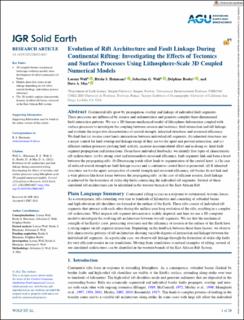| dc.contributor.author | Wolf, Lorenz | |
| dc.contributor.author | Huismans, Ritske Sipke | |
| dc.contributor.author | Wolf, Sebastian Georg | |
| dc.contributor.author | Rouby, Delphine | |
| dc.contributor.author | May, Dave A. | |
| dc.date.accessioned | 2023-04-04T11:40:28Z | |
| dc.date.available | 2023-04-04T11:40:28Z | |
| dc.date.created | 2023-01-16T09:21:04Z | |
| dc.date.issued | 2022 | |
| dc.identifier.issn | 2169-9313 | |
| dc.identifier.uri | https://hdl.handle.net/11250/3062083 | |
| dc.description.abstract | Continental rifts grow by propagation, overlap and linkage of individual fault segments. These processes are influenced by erosion and sedimentation and generate complex three-dimensional fault-interaction patterns. We use a 3D thermo-mechanical model of lithosphere deformation coupled with surface processes to investigate the coupling between erosion and tectonics, fault interaction and rift linkage, and evaluate the respective characteristics of crustal strength, inherited structures and erosional efficiency. We find that (a) weaker crust limits interactions between individual rift segments, (b) inherited structures are a major control for fault overlap and linkage except if they are too far apart and prevent interaction, and (c) efficient surface processes prolong fault activity, increase accommodated offset and in doing so, limit fault segment propagation and interactions. From these individual feedbacks, we identify five types of characteristic rift architectures: (a) for strong crust and intermediate erosional efficiency, fault segments link and form a horst between the propagating rifts. (b) Decreasing notch offset leads to segmentation of the central horst. (c) In case of reduced crustal strength no fault linkage occurs and a continuous central horst is promoted. (d) If inherited structures are too far apart, irrespective of crustal strength and erosional efficiency, rift basins do not link and a wide plateau-like horst forms between the propagating rifts. (e) In case of efficient erosion, fault linkage is achieved by the formation of strike-slip faults connecting the individual rift segments. Several of these simulated rift architectures can be identified in the western branch of the East African Rift. | en_US |
| dc.language.iso | eng | en_US |
| dc.publisher | AGU | en_US |
| dc.rights | Navngivelse-Ikkekommersiell 4.0 Internasjonal | * |
| dc.rights.uri | http://creativecommons.org/licenses/by-nc/4.0/deed.no | * |
| dc.title | Evolution of Rift Architecture and Fault Linkage During Continental Rifting: Investigating the Effects of Tectonics and Surface Processes Using Lithosphere-Scale 3D Coupled Numerical Models | en_US |
| dc.type | Journal article | en_US |
| dc.type | Peer reviewed | en_US |
| dc.description.version | publishedVersion | en_US |
| dc.rights.holder | Copyright 2022 The Author(s) | en_US |
| dc.source.articlenumber | e2022JB024687 | en_US |
| cristin.ispublished | true | |
| cristin.fulltext | original | |
| cristin.qualitycode | 2 | |
| dc.identifier.doi | 10.1029/2022JB024687 | |
| dc.identifier.cristin | 2107368 | |
| dc.source.journal | Journal of Geophysical Research (JGR): Solid Earth | en_US |
| dc.identifier.citation | Journal of Geophysical Research (JGR): Solid Earth. 2022, 127 (12), e2022JB024687. | en_US |
| dc.source.volume | 127 | en_US |
| dc.source.issue | 12 | en_US |

